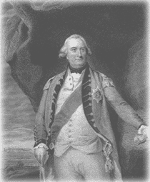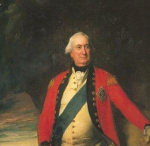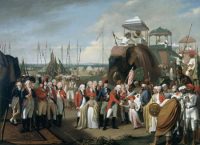Charles Cornwallis is probably most well-known for being the British commander who surrendered to George Washington at Yorktown, effectively ending the Revolutionary War. He did have an otherwise successful military career and, before the war, had a good amount of sympathy for the complaints of America's colonists. 
Cornwallis was born in London on Dec. 31, 1738, to parents Charles and Elizabeth. His father was the 1st Earl Cornwallis. Young Charles studied at Eton and then at Clare College, Cambridge. He studied at a military academy in Turin, Italy, and saw his future in the military. He joined the British Army, serving in the Seven Years War for a few years. He was elected to Parliament in 1760 and then succeeded his father in the House of Lords. Cornwallis opposed the Stamp Act, voting to repeal it, and was one of only five members of the House of Lords to vote against the Declaratory Act, a 1766 statue that reaffirmed Parliament's authority in the American colonies. Cornwallis earned a seat on the Privy Council in 1770 and appointment to the position of Constable of the Tower of London the following year. He had married Jemima Jones in 1768; they had a daughter and a son. 
Despite his support for the rights of the American colonists, he took his military duty to the Crown seriously and volunteered for active duty after the start of the Revolutionary War. Serving under Commander Sir William Howe, he proved himself an effective commander, getting the better of George Washington more than once. Cornwallis won the Battle of Long Island and then took Fort Washington and Fort Lee, eventually forcing the Continental Army out of New York City altogether. New Jersey was a slightly different story. After Washington's daring crossing of the Delaware River and a smashing victory over Hessian troops at the Battle of Trenton, Cornwallis had an opportunity to inflict heavy casualties on an exhausted American force outside Princeton but let them slip away under cover of night. Cornwallis had better success against Washington and the Continental Army in the Pennsylvania campaign, winning at Brandywine and Germantown; this eventually led to the British seizure of Philadelphia. Cornwallis took a planned leave of absence and returned home to England. Right after his return to the war, he was straight into the thick of it, at the Battle of Monmouth. Not long afterward, he had word that his wife was doing and sped back to England. She died in February 1779, and he stayed in England the rest of the year. Back in American again, he was second-in-command to General Henry Clinton and played an instrumental part in the near complete takeover of the Carolinas and Georgia, punctuated by the seizure of Charleston in May 1780 and a devastating victory at the Battle of Camden on August 16. The American general at Camden was Horatio Gates. He was soon replaced by Nathanael Greene. Under Greene, the American fortunes began to turn. At first, Cornwallis maintained the upper hand, technically holding the field at the Battle of Guildford Courthouse but sustaining heavy losses. Cornwallis, without consulting Clinton, turned northward, aiming to take Virginia as well. The British Army had much difficulty in the South at this point, with Greene defeating Cornwallis at Kings Mountain and Cowpens and Francis Marion, the noted guerrilla leader known as the "Swamp Fox," creating havoc in South Carolina. Cornwallis, acting more and more independently of Clinton, who was stuck far to the north and effectively unable to send reinforcements, pressed north, ending up on the Yorktown peninsula. What he thought was a good position for reinforcements turned out to be an ideal place for a siege, by American and French forces. Battle followed siege, and Cornwallis surrendered to Washington on Oct. 17, 1781. The British Army surrendered Charleston the following year. Cornwallis went home to England. 
In 1796, Cornwallis became the first Governor-General of India; among his successes there were a series of land and governmental reforms. The following year, he was appointed Lord Lieutenant of Ireland, where he helped thwart a French invasion. He was instrumental in helping Ireland pass the Act of Union 1800, creating the United Kingdom, and also played a part in the negotiations that firmed up the terms of the Treaty of Amiens, which ended the War of the Second Coalition against France. He returned in 1805 to India and died there a few months later. |
|
Social Studies for Kids
copyright 2002–2025
David White




